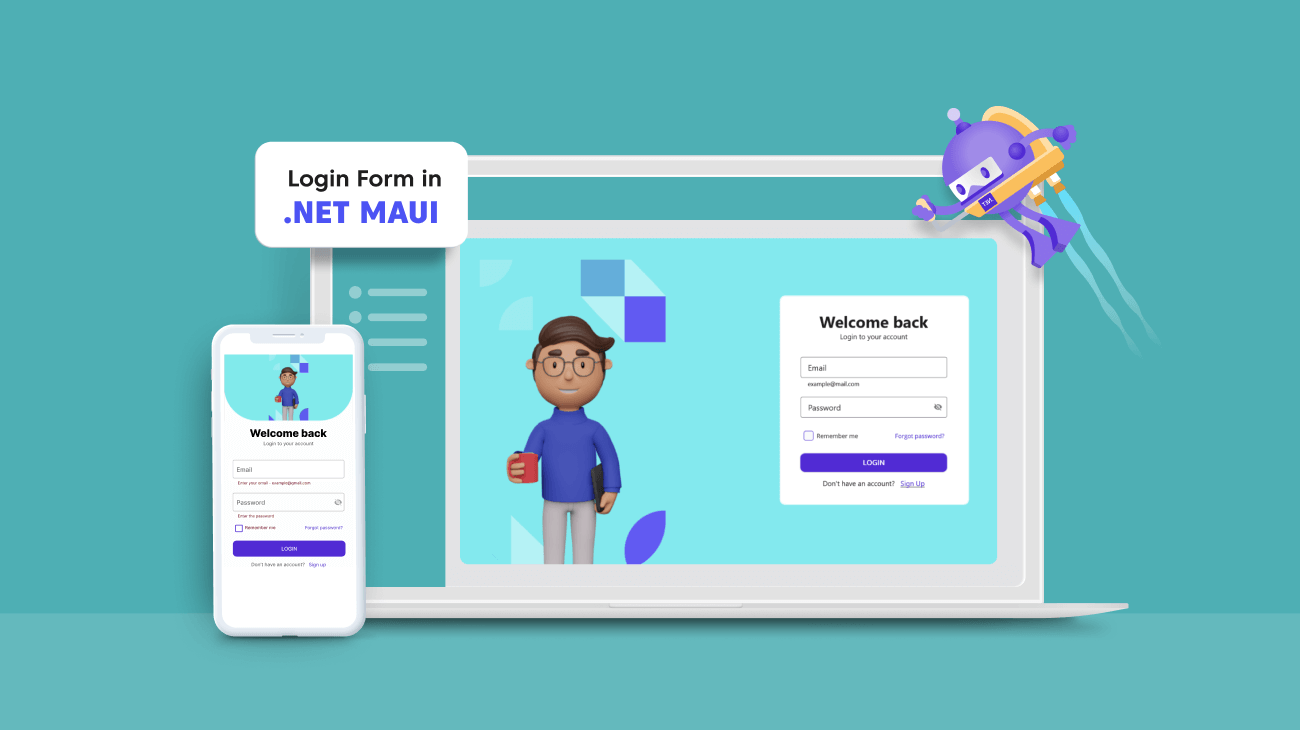

A login form allows users to enter their credentials, such as an email address and password, to authenticate and gain access to a website or application.
The .NET MAUI DataForm can be used to create various data forms. In this blog, I will explain how to develop and validate a login data form using the .NET MAUI DataForm.
Refer to the following code to initialize the .NET MAUI DataForm.
MainPage.xaml
xmlns:dataForm="clr-namespace:Syncfusion.Maui.DataForm;assembly=Syncfusion.Maui.DataForm" <dataForm:SfDataForm x:Name="loginForm"/>
Register the ConfigureSyncfusionCore handler for Syncfusion core in the MauiProgram.cs file.
MauiProgram.cs
using Syncfusion.Maui.Core.Hosting;
public static class MauiProgram
{
public static MauiApp CreateMauiApp()
{
var builder = MauiApp.CreateBuilder();
builder.ConfigureSyncfusionCore();
}
} Create a login form with the following fields to get email addresses and passwords.
LoginFormModel.cs
public class LoginFormModel
{
[Display(Prompt = "example@mail.com", Name = "Email")]
public string Email{ get; set; }
[Display(Name = "Password")]
[DataType(DataType.Password)]
public string Password { get; set; }
} By default, the data form auto-generates the data editors based on primitive data types such as string, enumeration, DateTime, and TimeSpan in the DataObject property.
You can change the editor layout default (label and editor) and floating label layout using the LayoutType property.
Refer to the following code example. In it, we set the data form model (LoginFormModel) to the DataObject property from the view model class to create the data editors for the login form with a floating label layout.
Please refer to the code to bind the LoginFormModel property from the DataFormViewModel class.
MainPage.xaml
...
<ContentPage.BindingContext>
<local:DataFormViewModel/>
</ContentPage.BindingContext>
<dataForm:SfDataForm x:Name="loginForm" DataObject="{Binding LoginFormModel}" LayoutType="TextInputLayout" /> Refer to the code to initialize the LoginFormModel property.
DataFormViewModel.cs
public class DataFormViewModel
{
/// <summary>
/// Initializes a new instance of the <see cref="DataFormViewModel" /> class.
/// </summary>
public DataFormViewModel()
{
this.LoginFormModel = new LoginFormModel();
}
/// <summary>
/// Gets or sets the login form model.
/// </summary>
public LoginFormModel LoginFormModel { get; set; }
} Let’s design the login page with images, buttons, checkboxes, and labels.
Refer to the following code to add an image to the login form.
MainPage.xaml
<Border Grid.ColumnSpan="{OnIdiom Default=2, Desktop=1}" Stroke="Transparent" Background="{OnIdiom Phone=#83E9EE,Desktop=Transparent}" Grid.RowSpan="{OnIdiom Default=1, Desktop=2}">
<Border.StrokeShape>
<RoundRectangle CornerRadius="0,0,100,100"/>
</Border.StrokeShape>
<Image Source="login.png" Grid.Row="0" Grid.Column="0" HorizontalOptions="Center" Aspect="AspectFit"/>
</Border> Next, add the Remember Me checkbox and Forgot password label in the login form.
MainPage.xaml
<Grid ColumnDefinitions="0.5*,0.5*" Grid.Row="2" Padding="12,0,0,0" VerticalOptions="Start">
<HorizontalStackLayout VerticalOptions="Center" Padding="10,0,0,0" >
<CheckBox Color="{StaticResource Primary}"/>
<Label Text="Remember me" FontSize="12" VerticalOptions="Center" />
</HorizontalStackLayout>
<Label Text="Forgot password?" Grid.Column="1" TextColor="{StaticResource Primary}" HorizontalTextAlignment="Center" Padding="10,0,0,0" FontSize="12" VerticalOptions="Center" />
</Grid> Then, add the LOGIN button in the login form.
MainPage.xaml
<Button Text="LOGIN" x:Name="loginButton" HeightRequest="40" VerticalOptions="End"
HorizontalOptions="Fill" Margin="20,0,20,0" CornerRadius="10"
Padding="0" FontAttributes="Bold"
Grid.Row="3" Background="{StaticResource Primary}"/> Next, refer to the following code to add the Don’t have an account? Sign Up label in the login form. You can refer to this blog for how to create a signup form.
MainPage.xaml
<Label Grid.Row="4" Padding="0,12,0,0" HorizontalOptions="Center" HorizontalTextAlignment="Center" FontSize="14">
<Label.FormattedText>
<FormattedString>
<Span Text="Don't have an account? " />
<Span Text="Sign Up" TextDecorations="Underline" TextColor="{StaticResource Primary}"/>
</FormattedString>
</Label.FormattedText>
</Label> Use the email field keyboard by updating the keyboard property in the GenerateDataFormItem event.
Refer to the following code to change the keyboard for the email editor.
MainPage.xaml
<ContentPage.Behaviors> <local:LoginFormBehavior/> </ContentPage.Behaviors>
LoginFormBehavior.cs
this.dataForm = bindable.FindByName<SfDataForm>("loginForm");
this.dataForm.GenerateDataFormItem += this.OnGenerateDataFormItem;
private void OnGenerateDataFormItem(object sender, GenerateDataFormItemEventArgs e)
{
if (e.DataFormItem != null && e.DataFormItem.FieldName == nameof(LoginFormModel.Email) && e.DataFormItem is DataFormTextEditorItem textItem)
{
textItem.Keyboard = Keyboard.Email;
}
} The email address and password fields must not be empty. If either field is left blank or has invalid data, an error message will be displayed, and the user cannot submit the form.
Please refer to the code to add EmailAddress and Required validation attributes.
LoginFormModel.cs
public class LoginFormModel
{
[Display(Prompt = "example@mail.com", Name = "Email")]
[EmailAddress(ErrorMessage = "Enter your email - example@mail.com")]
public string Email { get; set; }
[Display(Name = "Password")]
[DataType(DataType.Password)]
[Required(ErrorMessage = "Enter the password")]
public string Password { get; set; }
} The data form supports validating the data by using the ValidationMode property.
Refer to the following code to set the validation mode to PropertyChanged; the value will be validated immediately when changed.
MainPage.xaml
<dataForm:SfDataForm x:Name="loginForm" LayoutType="TextInputLayout" Grid.Row="1" DataObject="{Binding LoginFormModel}" ValidationMode="PropertyChanged" >
<ContentPage.Behaviors>
<local:LoginFormBehavior/>
</ContentPage.Behaviors> Login form validation can be handled while submitting the login button using the Validate method.
LoginFormBehavior.cs
private async void OnLoginButtonCliked(object sender, EventArgs e)
{
if(this.dataForm != null && App.Current?.MainPage != null)
{
if(this.dataForm.Validate())
{
await App.Current.MainPage.DisplayAlert("", "Signed in successfully", "OK");
}
else
{
await App.Current.MainPage.DisplayAlert("", "Please enter the required details", "OK");
}
}
} Refer to the GitHub demo on this topic.
Thanks for reading. This blog demonstrated how to create and validate a login form using the .NET MAUI DataForm control. Try out the steps in this blog and leave your feedback in the comments section below.
For current Syncfusion customers, the newest version of Essential Studio® is available from the license and downloads page. If you are not a customer, try our 30-day free trial to check out these new features. If you have questions, contact us through our support forums, feedback portal, or support portal. We are always happy to assist you!